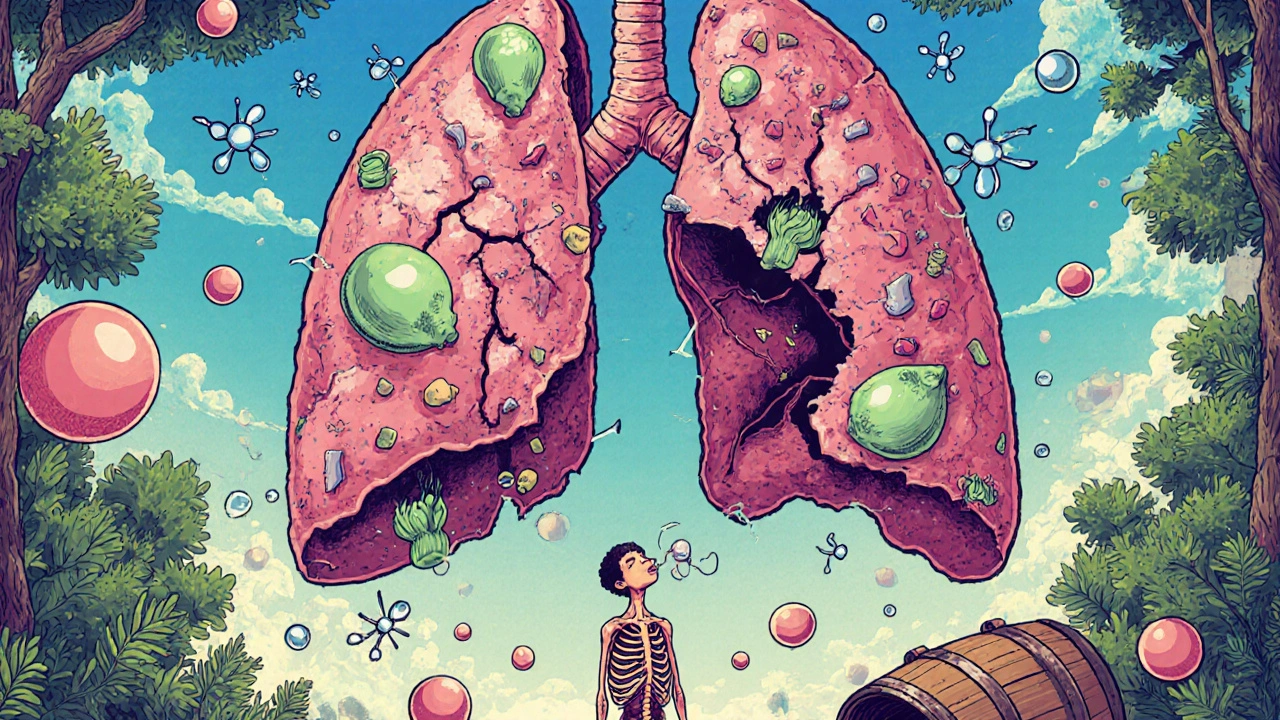When you hear the word COPD, it’s often treated like one disease. But that’s misleading. Chronic bronchitis and emphysema aren’t just two sides of the same coin-they’re different diseases that happen to live under the same roof. And knowing which one you’re dealing with changes everything: how you breathe, how you’re treated, even how long you might live.
What’s Actually Happening in Your Lungs?
Think of your lungs like a tree. The branches are your airways. The leaves are your alveoli-the tiny sacs where oxygen enters your blood and carbon dioxide leaves. In chronic bronchitis, the branches swell up, get coated in thick mucus, and clog up. In emphysema, the leaves fall off and the tree’s structure collapses.
Chronic bronchitis is defined by a cough that brings up mucus-every day, for at least three months a year, over two years straight. That’s not just a cold that won’t quit. It’s your body’s defense system going haywire. The mucus glands in your airways grow 300% to 500% larger. You’re producing 100 to 200 milliliters of mucus daily-enough to fill a small water bottle. Cilia, the tiny hairs that normally sweep mucus out, stop working. So the mucus piles up, traps bacteria, and triggers infections. That’s why winter is brutal for these patients: cold air makes mucus thicker, and viruses spread faster.
Emphysema is quieter but deadlier. It doesn’t make you cough much. Instead, it steals your breath. The walls between your alveoli break down. They don’t just thin-they vanish. What was once hundreds of tiny, elastic sacs becomes a few huge, floppy air pockets. Your lungs lose their natural spring. When you exhale, they can’t snap back. Air gets trapped. Your lungs balloon. That’s why many patients develop barrel chests-their ribcages permanently expanded from years of overinflation. Oxygen can’t cross into the bloodstream efficiently. DLCO (diffusing capacity for carbon monoxide) drops below 60% of normal. In advanced cases, it’s closer to 30%.
How Do You Know Which One You Have?
You can’t tell just by symptoms. But there are clear patterns.
Emphysema patients are often called “pink puffers.” They look relatively healthy-skin color normal-but they’re gasping. Why? Because their bodies are working overtime to get oxygen. They breathe fast-25 to 30 breaths per minute-forcing air out through pursed lips. They’re thin. They can’t walk far without stopping. Their oxygen levels stay near normal (92-95%) because they hyperventilate. But their lungs are failing internally.
Chronic bronchitis patients are the “blue bloaters.” Their skin may look bluish, especially around the lips and fingers. Their oxygen levels are low-85% to 89%. They retain carbon dioxide. Their hearts struggle. Fluid builds up in their legs. They’re often heavier. They cough all day. They wake up choking on mucus. One patient on Reddit measured his morning mucus output with a measuring cup: 100 mL, every day, for eight years.
But here’s the catch: 85% of people with severe COPD have features of both. Pure cases are rare. Still, one side usually dominates. That’s why doctors need more than just a stethoscope.

Testing That Makes the Difference
A simple spirometry test (FEV1/FVC ratio below 70%) confirms COPD. But it doesn’t tell you if it’s bronchitis or emphysema.
To tell the difference, you need:
- DLCO test: If it’s below 60% of predicted, emphysema is likely. If it’s normal or only slightly low, bronchitis is the main issue.
- High-resolution CT scan: Emphysema shows up as dark, low-density patches covering more than 15% of the lung. Bronchitis shows thickened airway walls-wall area percentage over 60%.
- 6-minute walk test: Emphysema patients drop their oxygen below 88% within two minutes. Bronchitis patients stop because they’re out of breath, but their oxygen stays stable.
Many primary care doctors skip these tests. But pulmonologists-78% of whom routinely use them-know this is where treatment decisions are made.
Treatment Isn’t One-Size-Fits-All
Here’s where things get personal. One person gets a steroid inhaler. Another gets surgery. Both are COPD. But only one is right for them.
For chronic bronchitis:
- Mucolytics like carbocisteine reduce flare-ups by 22%. They thin the mucus so you can cough it out.
- Hypertonic saline nebulizers (7% salt water) help 73% of patients clear mucus faster.
- Roflumilast cuts exacerbations by 17.3%-but only if you’ve had two or more flare-ups a year.
- Avoid inhaled steroids if you’re a blue bloater. They raise your pneumonia risk by 40%.
For emphysema:
- Lung volume reduction surgery or endobronchial valves help if your disease is mostly in the upper lobes and your FEV1 is below 35%. Success rate? 65% at one year.
- Alpha-1 antitrypsin augmentation is a weekly IV drip for the 1-2% of emphysema patients with a genetic defect. New inhaled versions now show 20% FEV1 improvement in 12 months.
- Oxygen therapy is life-saving-but many patients hate it. Portable concentrators deliver 2-4 liters per minute, but they’re heavy. One patient said, “I used to walk to the mailbox. Now I sit by the window and watch the birds.”
Both groups benefit from LAMA/LABA inhalers (long-acting bronchodilators). That’s the first-line standard. But adding the wrong thing-like steroids to a bronchitis patient-can hurt you.

Why This Matters Beyond the Clinic
The economic burden is massive. Emphysema patients spend $38,500 a year-75% of it on hospital stays. Bronchitis patients spend $29,800-mostly on meds and doctor visits. The global COPD drug market hit $12.8 billion in 2023. And it’s splitting: new drugs like ensifentrine (targeting mucus) made $142 million in its first year. Endobronchial valves grew 22% annually.
Regulators are catching up. Since 2022, the FDA requires all new COPD trials to separate results by phenotype. That’s huge. It means future drugs will be designed for specific types of lung damage-not just “COPD” as a vague label.
But here’s the real problem: most patients don’t know which type they have. A 2023 survey found only 42% of primary care doctors routinely differentiate between bronchitis and emphysema. That means half the people getting COPD treatment are being managed like someone else.
What’s Next? Hope on the Horizon
There’s real progress. In 2024, Europe approved a new acoustic device that vibrates mucus loose in chronic bronchitis patients-reducing flare-ups by 32%. In the U.S., bronchoscopic thermal vapor ablation is showing 78% success in reducing emphysema over two years.
Researchers are now hunting for biomarkers. Blood eosinophils above 300 cells/μL might predict who responds best to new biologic drugs. The NIH’s SPIROMICS-2 study, tracking 10,000 patients through 2026, could change how we classify COPD forever.
Dr. James Crapo put it best: “The future of COPD management lies not in treating it as a single disease, but in precisely targeting its component pathologies.”
If you or someone you love has COPD, ask for a DLCO test. Ask if your CT scan showed emphysema patterns. Ask if your treatment plan matches your phenotype. You’re not just managing a disease. You’re fighting two different battles-and you need the right weapons for each.
Can you have chronic bronchitis without emphysema?
Yes, but it’s uncommon. Most people with chronic bronchitis have some degree of emphysema, especially if they’ve smoked for years. However, you can be diagnosed with chronic bronchitis if you meet the clinical criteria-cough with mucus for 3 months a year over 2 years-without significant alveolar destruction. In these cases, the main problem is airway inflammation and mucus overproduction, not loss of lung elasticity.
Is emphysema worse than chronic bronchitis?
Neither is “worse”-they’re just different. Emphysema tends to cause more severe breathing limitations and faster decline in lung function, especially in advanced stages. But chronic bronchitis leads to more frequent infections, hospitalizations, and complications like heart failure from low oxygen. Survival rates are similar when managed properly. The key isn’t which one you have-it’s whether you’re getting the right treatment for your specific condition.
Can COPD be reversed?
No, the structural damage from emphysema or chronic airway remodeling from bronchitis can’t be undone. But progression can be slowed dramatically. Quitting smoking is the single most effective step. Pulmonary rehab, proper medications, and avoiding infections can help you maintain function for decades. Some patients even improve their exercise capacity and quality of life significantly-even if their lung scans don’t change.
Why do some COPD patients use oxygen and others don’t?
Oxygen therapy is prescribed when blood oxygen levels stay low at rest-usually below 88%. This is common in advanced emphysema because the lungs can’t transfer oxygen efficiently. Chronic bronchitis patients often have normal oxygen levels because they hyperventilate to compensate. But if their condition worsens and they develop cor pulmonale (heart strain from low oxygen), they’ll also need oxygen. It’s not about the diagnosis-it’s about your actual blood oxygen numbers.
What’s the best way to clear mucus if you have chronic bronchitis?
Several methods work well. Chest physiotherapy (clapping on the back or using a vibrating vest) helps move mucus. Hypertonic saline nebulizers thin it out. Mucolytics like carbocisteine make it less sticky. New acoustic devices vibrate the airways to loosen secretions. Staying hydrated is critical-mucus thickens when you’re dehydrated. Avoid antihistamines-they dry out secretions and make them harder to clear.
Do I need a CT scan to diagnose COPD?
No, a spirometry test is enough to diagnose COPD. But if your doctor suspects emphysema or wants to plan advanced treatment-like lung volume reduction surgery-a CT scan is essential. It shows exactly where the damage is and how much. Many patients skip it because they don’t understand its value. But if you’re considering surgery or new medications, a CT scan isn’t optional-it’s the roadmap.







Richard Wöhrl
November 21, 2025 AT 15:35Wow, this breakdown is insane. I never realized mucus production could hit 200ml a day-that’s like a small water bottle of gunk every 24 hours. And the cilia just giving up? That’s not a cough, that’s a full-blown rebellion inside your lungs. DLCO below 30%? That’s not just breathless-that’s your lungs screaming for mercy. This isn’t just medical info, it’s a survival guide.
Katy Bell
November 22, 2025 AT 12:32I had a friend who was a ‘blue bloater’-she’d sit on her porch every morning with a measuring cup, like it was coffee. Said she could tell how bad the air quality was by how thick the mucus was. I never thought of it like that. But she’s been on hypertonic saline for three years now and says it’s the only thing that lets her sleep. I cried reading that.
Brandy Walley
November 22, 2025 AT 23:48So you’re telling me if you’re fat and coughing you get one treatment but if you’re skinny and panting you get surgery? Like its some kind of weight based medical hierarchy? Whatever. I bet the drug companies love this. Just keep selling inhalers and call it a day.
Pramod Kumar
November 23, 2025 AT 07:55Man, this hit different. I lost my uncle to this-used to call him ‘Mr. Barrel Chest.’ He’d sit on the porch with his oxygen tank like it was his third arm. Never complained. But you know what he asked me once? ‘Son, do you think they’ll ever make a pill that just… fixes the holes?’ I didn’t know what to say. This post? It answers that. Not perfectly. But better than any doctor ever did.
Vivian C Martinez
November 24, 2025 AT 02:26Thank you for writing this with such clarity. Many patients are left confused because COPD is treated as a monolith. The distinction between bronchitis and emphysema isn’t academic-it’s life-altering. If you’re on steroids and you’re a blue bloater, you’re increasing your pneumonia risk by 40%. That’s not a side note. That’s a red flag. Please share this with your primary care provider.
Casper van Hoof
November 24, 2025 AT 07:45The metaphor of the tree-branches versus leaves-is elegantly reductive. Yet, in its simplicity, it captures the ontological fracture within COPD: one is a disease of excess (mucus, inflammation, obstruction), the other of absence (elasticity, alveolar integrity, structural fidelity). The clinical distinction, then, is not merely diagnostic-it is existential. To treat them as identical is to commit a category error of the highest order. The future of pulmonary medicine lies not in pharmacological generalization, but in phenotypic precision.
shreyas yashas
November 24, 2025 AT 13:00My dad’s a smoker. 68. Coughs every morning like a rusty engine. He thinks it’s just ‘smoker’s cough.’ I showed him this. He sat quiet for 10 minutes. Then said, ‘So… I’m not just old. I’m broken.’ I didn’t know what to say. But I took him to the pulmonologist this week. Got the DLCO test. Turns out, he’s got early emphysema. He’s quitting. Not because he’s scared. Because now he knows what he’s fighting.
Ragini Sharma
November 25, 2025 AT 23:11so like… if u have bronchitis u r a blue bloater and if u have emphysema u r a pink puffer?? like… is this some kind of anime character classification? also why does everyone sound like a textbook? i just want to know if my cough is gonna kill me or just make me late for work
Jennifer Shannon
November 27, 2025 AT 10:12I’m from New Orleans-we’ve got a lot of people with COPD here, especially after Katrina. The humidity, the mold, the secondhand smoke at jazz funerals… it’s a perfect storm. I met a woman last year who used to be a jazz singer. Now she uses a nebulizer before she sings ‘What a Wonderful World.’ She says the salt water lets her hit the high notes again. I cried. Not because it’s sad-because it’s beautiful. This isn’t just about lungs. It’s about music. About breath. About refusing to let a disease steal your voice. And honestly? That’s what keeps people going. Not the stats. Not the drugs. Just the chance to sing one more song.
Suzan Wanjiru
November 28, 2025 AT 15:51CT scans for emphysema? Really? You need a $2000 scan to know your lungs are destroyed? Why not just ask if they can walk to the mailbox? Also, who the hell is paying for all this? Insurance? Taxpayers? My cousin got a valve implant and now he’s on disability. He never worked a day in his life. This whole system is rigged.
Linda Rosie
November 28, 2025 AT 19:44Accurate phenotyping is essential. The FDA’s 2022 requirement is a necessary step forward. Clinical trials must stratify by COPD phenotype to ensure therapeutic efficacy is properly evaluated. Failure to do so constitutes a significant methodological flaw.
Bryson Carroll
November 29, 2025 AT 04:31Look I’ve read a lot of medical blogs and this one is basically just a drug company ad with fancy metaphors. You want to sell more inhalers? Fine. But don’t pretend you care about patients when your whole business model is based on keeping them sick. Bronchitis? Emphysema? Whatever. Just give me a pill that works and stop making me read 2000 words about trees
Suresh Ramaiyan
November 30, 2025 AT 17:47It’s funny how we call them ‘blue bloaters’ and ‘pink puffers’ like they’re nicknames for sports teams. But behind those labels are people. People who wake up choking. People who can’t hug their grandkids without stopping to breathe. This isn’t just about science-it’s about dignity. The fact that we can now target treatments? That’s not progress. That’s justice. And it’s long overdue.
Ross Ruprecht
December 1, 2025 AT 08:49So… what’s the takeaway? Just don’t smoke? That’s it? I mean… I read all that and the only thing I remember is ‘don’t be a blue bloater.’